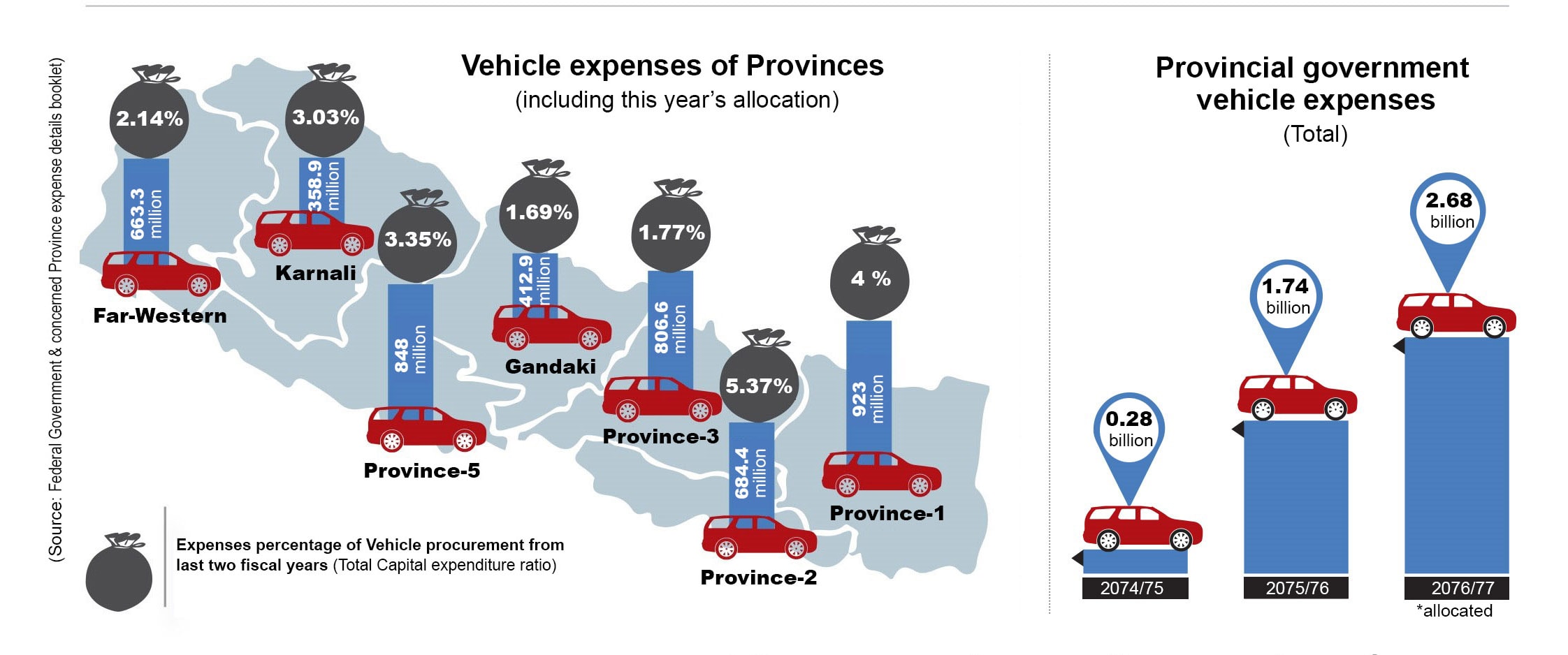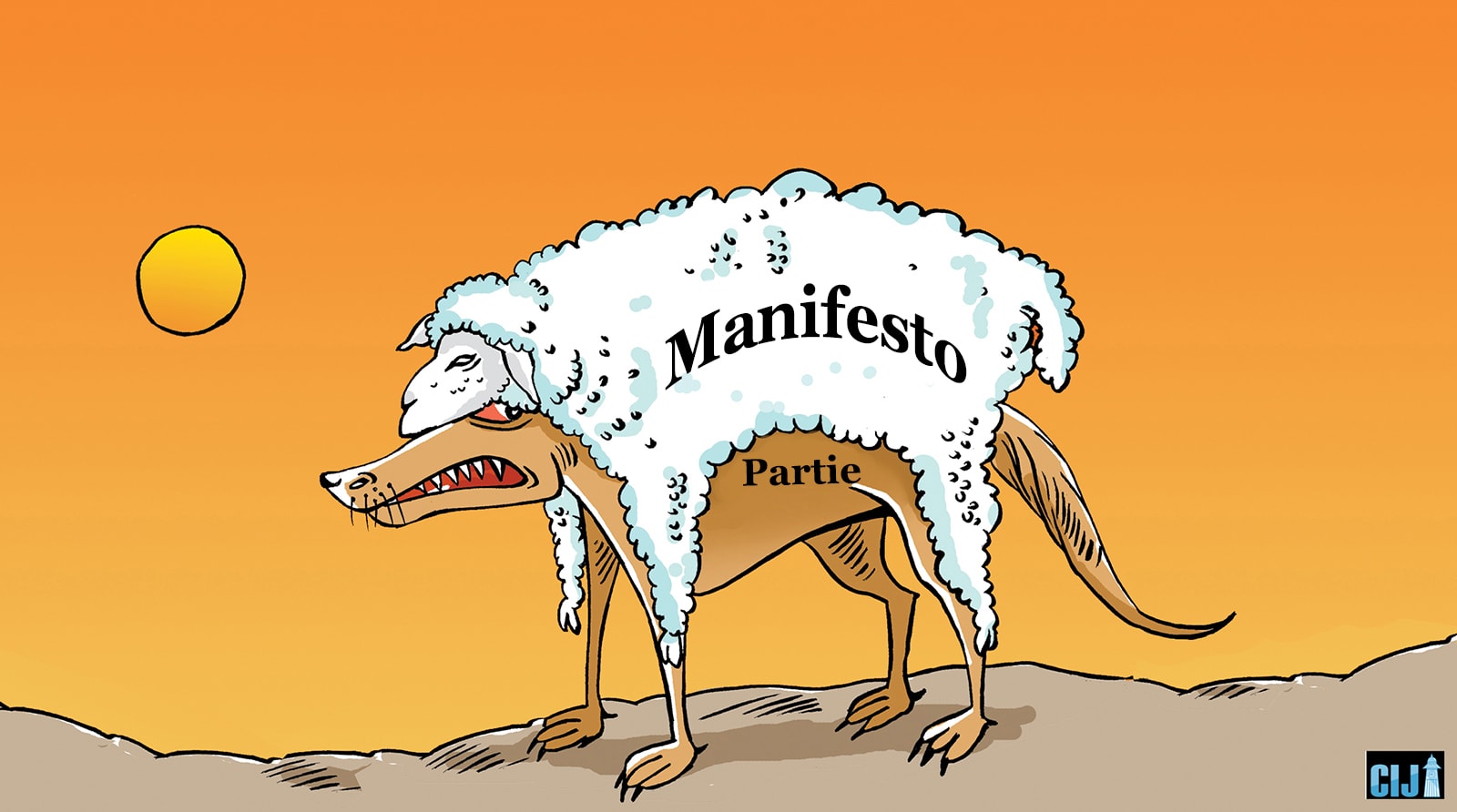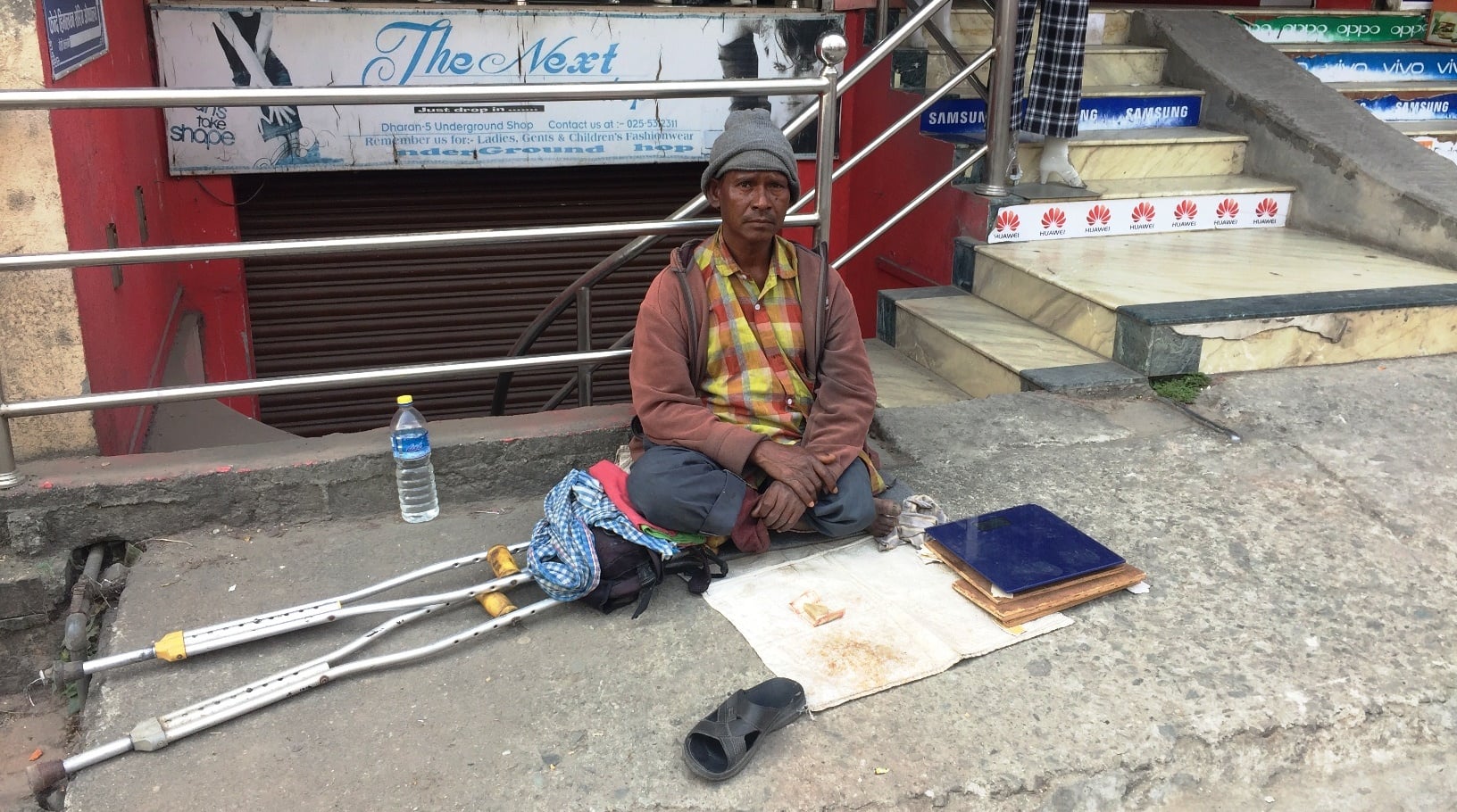In what can be termed as a flagrant blow to the law, government authorities appear to be glued onto the wheels of corruption and extracting commission. Even more depressing part we see that government vehicles suffer unwarranted wear and tear, coupled with escalating costs of maintenance, repair work, and fuel.
Ramesh Kumar: Centre for Investigative Journalism-Nepal
Contrary to what is stipulated in the Budget Execution Guidelines 2076 BS, the federal and provincial governments have spent Rs 21.186 billion in the procurement of new vehicles in the last three years in what can be labeled as extortionate spending of the tax-payers’ money.
And if the budget allocated for purchasing vehicles for the fiscal year 2019/20 is to be included in the list, the total spending would exceed Rs 25 billion. Interestingly, there are no integrated expenditure details available about the vehicles that have been purchased by local levels and for various other projects. It is a blatant breach of the government’s policy of being cost-effective and economical, a necessary plank of maintaining altruism for a communist government. Now, the extortionate spending on new vehicles has contradicted its policy which proves that the government authorities have become more extravagant, draining out money from the state coffer.
The federal and provincial governments have utterly failed to deliver as promised to people in elections. Moreover, they have taken to a new height of being superfluously extravagant if the total expenditure on the procurement of vehicles is to be considered as a reason for concern. For instance, the government spent a total of Rs 1.17 billion in the fiscal year 2015/16 to purchase vehicles. The figure has increased swiftly by six and a half folds in the last six years.
The provincial and local level governments appear to be in a race in the procurement of new vehicles notwithstanding the criticism being heaped upon them from all walks of life. The federal government, too, seems to be following suit, instead of watching over the governments under it, by purchasing vehicles for the staffers and office-bearers to use.
The federal and provincial governments spent a total of Rs 21 billion to purchase vehicles in the last three years out of which the provincial governments drained out Rs 2 billion for the purchase of the vehicle.
As per data obtained from the Office of the Auditor-General for the fiscal year 2018/19, the federal and seven provincial governments together spent Rs 7.576 billion in the purchase of vehicles.

Similarly, the federal government spent Rs 5.838 billion to purchase vehicles that amount to around 2.45 percent of the total capital expenditure of the federal government (development-oriented expenditure).
Regrettably, the federal government, which has failed to spend the development budget, has spent outrageously fourfold of the development budget to purchase vehicles by diverting the initially allocated budget.
Last year’s budget had allocated Rs 1.44 billion for the purchase of vehicles. However, the government utilized the allocated development budget by transferring it to purchase vehicles, sans development activities, at the end of the fiscal year.
In what has been called a ‘case of dire need’, there is a provision of allocating budget to procure vehicles even at the beginning of the fiscal year. Former Secretary Purna Chandra Bhattarai describes the transfer of development budget to procure new vehicles as an ‘exorbitant attitude’.
Observers say this is symptomatic of a luxurious attitude that governments at all level are buying vehicles more than required in numbers to be used for personal work. Vehicles are being considered as gains by the people’s representatives and government authorities. Says former Secretary Kishor Thapa, “It is unfortunate that those in the leadership have been engaged in abusing their authority. Such a tendency will only encourage employees.”
Replacing running vehicles with new ones
The federal government has allocated Rs 1.49 billion, while the seven provincial governments have allocated Rs 2.67 billion to buy vehicles. However, there is no specific record about the expenditure by the local levels in the purchase of vehicles.
According to the 56th report of the Auditor General, only 622 vehicles out of the total 800 four-wheelers under 22 ministries in Singha Durbar are in operational condition. Even vehicles in good condition have been left lying unused for long. Evidence shows several new vehicles have been procured to replace vehicles which are in road-worthy (running) condition. A total of 201 vehicles have been handed over to various bodies following the instruction of the Prime Minister’s Office. “The practice of purchasing new vehicles for the commission is rampant,” says former finance secretary Rameshwor Khanal.
In some government bodies, vehicles have been purchased in haste even if vehicles are not required. For instance, in July this year, four Scorpio jeeps (of Mahindra Company) were purchased to replace old ones that were bought five years ago for the Office of Attorney General. The vehicles were, in fact, not required for the Deputy Attorney Generals.
Sixteen Scorpio jeeps were bought for chairpersons of the federal parliament in the last fiscal year to replace the vehicles bought a decade ago saying that those vehicles had become non-operational. This is against the Budget Execution Guidelines 2076 that clearly instructs to plan to procure new vehicles to replace old ones only after 15 years.
The situation is no less in other bodies as well. The National Inclusive Commission procured five vehicles each costing Rs 4 million in July last year meant for the Chairperson and four commissioners. After the resignation of Chairperson Dr. Shanta Raj Subedi, three commissioners are yet to be appointed while only one Commission is in office. These vehicles have been parked unused within the Commission premises.
This is just an example of how new vehicles are procured but remain unutilized. At the end of the fiscal year, the government allocated a budget for the procurement of vehicles meant for six commissions. However, the commissions, including the National Inclusive Commission, Dalit, Women, Janajati, Madhesi, Muslim, Tharu are yet to get a full shape. Interestingly, new vehicles have already been procured for the commissioners even though they are yet to be appointed. (See Picture)
The ‘Nepal Livestock Sector Innovation Project’ procured two KIA sports car each worth Rs 8 million last fiscal year. While the project chief has been using one car, the other one is being used by the secretary of the Ministry of Agriculture. The secretary has been using the new luxury car which was actually meant for the ADB-funded project. However, it is not because the ministry does not have a car but it was the greed on the part of the secretary.
According to the Auditor General’s 56th Report, there are 1,323 employees in 22 ministries. Interestingly, there are 1,577 operational vehicles in the ministries. Some high-level officials have been alleged of using two cars – one at home and one for official use.
The Ministry of Home Affairs has 90 officer-level staffers while there are 174 vehicles meant for them. The Office of Prime Minister has 151 vehicles for a total of 94 officer-level staffers. Legally, the number of vehicles has to be significantly less than the number of staffers. The tendency of acquiring vehicles soon after entering the civil service has led to rampant use of the state coffer.
The government employees are infringing the legal procedures while acquiring vehicles breaching the “Budget Execution Guidelines 2075” that mentions about the criteria of procuring vehicles. Since the Financial Procedure endorsed by the parliament will work as an Act, this Directive, too, would work as a law. According to the Act, only Gazetted First Class government officials above Joint-Secretaries are obliged to enjoy the facility of vehicle and driver. (See Picture)
Former Secretary Purna Chandra Bhattarai says there has been a provision to provide vehicles to senior government officials holding high-level positions such as the government joint secretary and above. “We even did not think of using such a facility before I became the joint secretary,” he says.
Contrary to what Bhattarai said, even government employees having political influence and power have been enjoying the facility. For instance, according to available data, almost all 35 joint secretaries enjoy vehicle facility. Data shows two officers of the ministry are using government vehicles. Consider what Uttar Kumar Khatri, Spokesperson at the Ministry has to say: “Forget about the Ministry of Finance, even joint-secretaries of other ministries, too, have been making the utmost use of government vehicles.”
Mockery of law
The concerned authority lacks the record of the actual data about the number of vehicles in the government office, forget about replacing the old ones. Joint Secretary at the Prime Minister’s Office Binod Bahadur Kunwar blames what he said ‘non-cooperating’ attitude of the staffers at the concerned ministries for not being able to keep the record of vehicles.

Former Secretary Purna Chandra Bhattarai points out the need for proper management of the government vehicles to control massive negligence of the vehicles. “It is high time that the concerned authorities formed criteria and implement it strictly to ensure procurement and proper management of the vehicles for government authorities,” he says.
The “Budget Execution Guidelines 2075’ has provisioned 1600-2000 CC petrol-run vehicle for ministers and 1300-1600 CC petrol-vehicles to members of the constitutional bodies and first-class government officers.
Government officials, such as joint-secretary, get a 1000 CC vehicle. However, this provision has been defied for years. For instance, joint secretaries at the Ministry of Finance have been using Hyundai Tucson of 2000 CC. Meanwhile, officers at the Ministry of Physical Infrastructure and Transport, Ministry of Home Affairs ride even more powerful, expensive luxury vehicles.
The Inland Revenue Department procured 14 vehicles, including seven Scorpio jeeps in the last fiscal year. Under Secretaries at the ministries use 2179 CC Scorpio jeeps. Likewise, three Creta cars (1396 CC) procured by the Department have been used by Joint Secretary level officials. A 3000 CC Land Cruiser Prado was purchased for the Election Commission (EC) two years ago despite already having expensive vehicles for the EC officials.
There has been evidence of vehicles being procured with the budget allocated for “Public Construction’ – an example of how tax-payers’ money has been drained out. The Drinking Water and Sewerage Department had in the fiscal year 2016/17 misused the budget of Rs 147.3 million allocated for construction by procuring vehicles.
Similarly, the EPS Korea branch had purchased a Scorpio worth Rs 5.66 million for its Director-General from the amount collected from migrant workers. There is also an instance of some government officers procuring new vehicles as soon as they are transferred. For example, the then secretary at the Ministry of Finance Lok Darshan Regmi had procured a Hyundai Tucson vehicle as soon as he was appointed at the secretary.
Moreover, there has been a rampant misuse of tax-payers’ money in the name of repair of worn-out vehicles and fuel. If the data of the Auditor General’s Office is to be considered, around Rs 6 billion has been spent on different headings such as repair, fuel, renewal, insurance, driver’s salary, among others by the federal government.
In the last fiscal year, the expenditure on fuel by the federal government reached Rs 2.87 billion. With the significant increase in the procurement of new vehicles, the expenditure on fuel is likely to increase further. Therefore, the budget has estimated around Rs 4.67 billion under the heading.
Likewise, a total of Rs 2.52 billion was spent in the name of repairing of vehicles in the last fiscal year, forget about the driver’s salary, insurance, and other expenditure.
Binod Bahadur Kunwar, Joint Secretary at the Prime Minister’s Office, says such tendency of draining out the money in the name of procurement of vehicles, repair, and fuel is certain to have a long-term impact to the country.
Liberal Finance Ministry
Even though the issue has been raised and discussed time and again, the government has not been able to make reforms in this sector fearing civil servants’ displeasure and anger. The Finance Ministry has at times allocated allowance for the procurement of luxury vehicles for the offices which do not need to go out of the Valley.
Former Secretary Bhattarai accuses the Ministry of Finance of being so liberal for the procurement of the vehicles. “Earlier, it used to be a Herculean task to convince the Ministry of Finance for vehicle procurement. Now, the ministry has become quite liberal.”
The Ministry of Finance has introduced and implemented “Policy Guidance on Maintaining Frugality and Effectiveness at Public Expenditure” in April 2018. It provisions a lump sum amount to the government officials for the expenditure, including driver’s salary, fuel, and repair.
Likewise, it has also barred government vehicles from using private number plates, as well as barring from purchasing new vehicles except for newly established offices. This, however, has not been implemented. Several government vehicles have been using private number plates.
The provision of providing transportation allowance to the government officers will curtail other expenditure such as fuel cost, repair cost, and drivers’ salary. Former Secretary Kishor Thapa suggests that unnecessary expenditure would decrease if the government offices implemented a policy of hiring vehicles from private companies whenever needed.
Meanwhile, the government has been procuring fuel-run vehicles by flouting its own policy of promoting electric and environment-friendly vehicles. The government in its current fiscal year Program and Policies has prioritized promotion of electric vehicles, which will curtail unnecessary expenditure, including fuel and repair. Moreover, this will also help in narrowing down the cost in the import of fuel, machinery parts as well as encourage the use of electric vehicles.
Former Finance Secretary Rameswor Khanal says that the administration has been creating impediments in procuring electric vehicles to ‘adjust’ the bill. If they don’t do so, their commission will go out of hand, he says. “Electric vehicles are not prioritized since the authorities cannot misuse the fuel and cannot even produce fake bills,” Khanal said.



